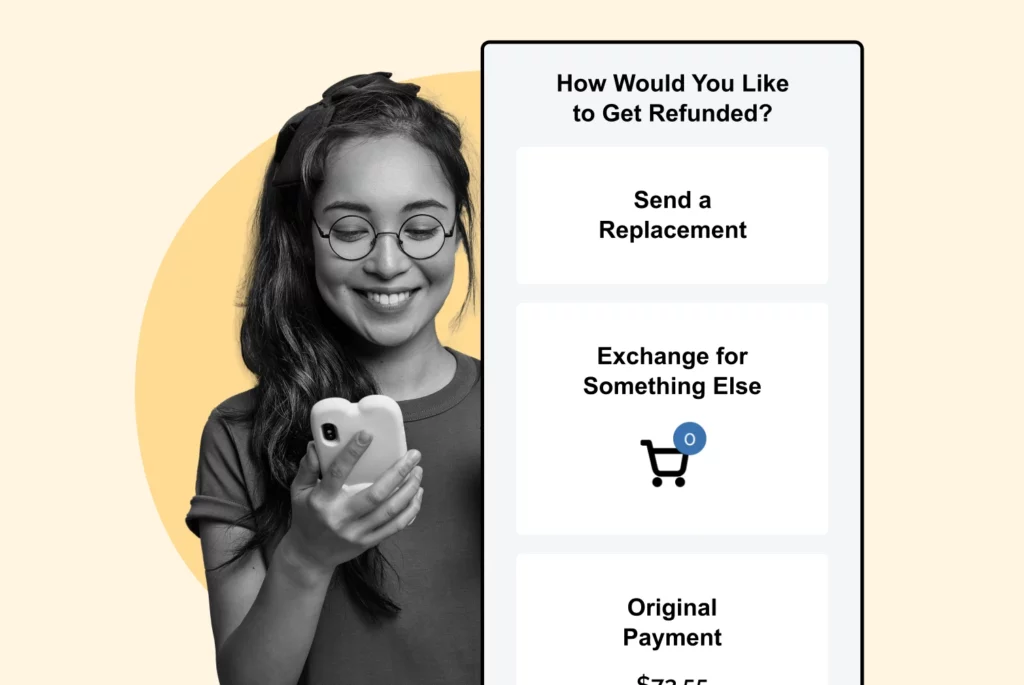
The 5 Most Important Returns Touchpoints
Discover the importance of returns in e-commerce and how a well-managed return process can improve customer satisfaction and drive business success.
Shipping, Tracking & Notifications
Boost customer experience and reduce support tickets
Realtime order and shipment tracking
Proactive order and shipping notifications
AI-Enhanced Discounted Labels
Predictive pre-purchase estimated delivery dates
Self-Serivce branded order tracking
Effortless experience delivered
Identify and Resolve Order Issues
Realtime order and shipment tracking
Make returns profitable and delight customers
Flexibility to define any return destinations & conditions
Simplify returns for your customers and team
Incentivize exchanges over returns
Returns management made easy for your team
Returns management made easy for your team
Easy claims and smart upsells
Understand why your customers are returning
In-Store & Curbside Pickup
Unify the online and the in-store experience
Hassle-free pickup experience for customers
In-Store dashboard to keep operations streamlined
In-Store and Online orders unified
Drive foot-traffic to your stores
Shipping, Tracking & Notifications
Boost customer experience and reduce support tickets
Realtime order and shipment tracking
Proactive order and shipping notifications
AI-Enhanced Discounted Labels
Predictive pre-purchase estimated delivery dates
Self-Serivce branded order tracking
Effortless experience delivered
Identify and Resolve Order Issues
Realtime order and shipment tracking
Make returns profitable and delight customers
Flexibility to define any return destinations & conditions
Simplify returns for your customers and team
Incentivize exchanges over returns
Returns management made easy for your team
Returns management made easy for your team
Understand why your customers are returning
In-Store & Curbside Pickup
Unify the online and the in-store experience
Hassle-free pickup experience for customers
In-Store Dashboard to keep operations streamlined
In-Store and Online orders unified
Drive foot-traffic to your stores
Boost customer experience and reduce support tickets
Realtime order and shipment tracking
Proactive order and shipping notifications
AI-Enhanced Discounted Labels
Predictive pre-purchase estimated delivery dates
Self-Serivce branded order tracking
Effortless experience delivered
Make returns profitable and delight customers
Flexibility to define any return destinations & conditions
Simplify returns for your customers and team
Incentivize exchanges over returns
Returns management made easy for your team
Equip your team for precise return checks.
Easy claims and smart upsells
Understand why your customers are returning
Unify the online and the in-store experience
Hassle-free pickup experience for customers
In-Store Dashboard to keep operations streamlined
In-Store and Online orders unified
Drive foot-traffic to your stores
Find the answer to all your questions
Take a step by step trip through our functionality to see how we can improve your ecommerce processes.
Explore the most comon questions about WeSupply
Calculate the ROI that WeSupply can bring you
Request a no strings attached review of your current shopping experience and missed conversion opportunities
Read actionable articles on how to optimize your post-purchase experience and decrease support tickets
Get inspired by stories of how our customers implemented an effortless post-purchase experience
Wondering if WeSupply is a good fit for you? Read through our use cases to see how we can help you increase conversion & improve CX!
A Deep Dive into Top Companies' Order Tracking & Returns Strategy
Find the answer to all your questions
Explore the most comon questions about WeSupply
Calculate the ROI that WeSupply can bring you
Request a no strings attached review of your current shopping experience and missed conversion opportunities
Take a step by step trip through our functionality to see how we can improve your ecommerce processes.
Read actionable articles on how to optimize your post-purchase experience and decrease support tickets
Get inspired by stories of how our customers implemented an effortless post-purchase experience
A Deep Dive into Top Companies' Order Tracking & Returns Strategy
Wondering if WeSupply is a good fit for you? Read through our use cases to see how we can help you increase conversion & improve CX!
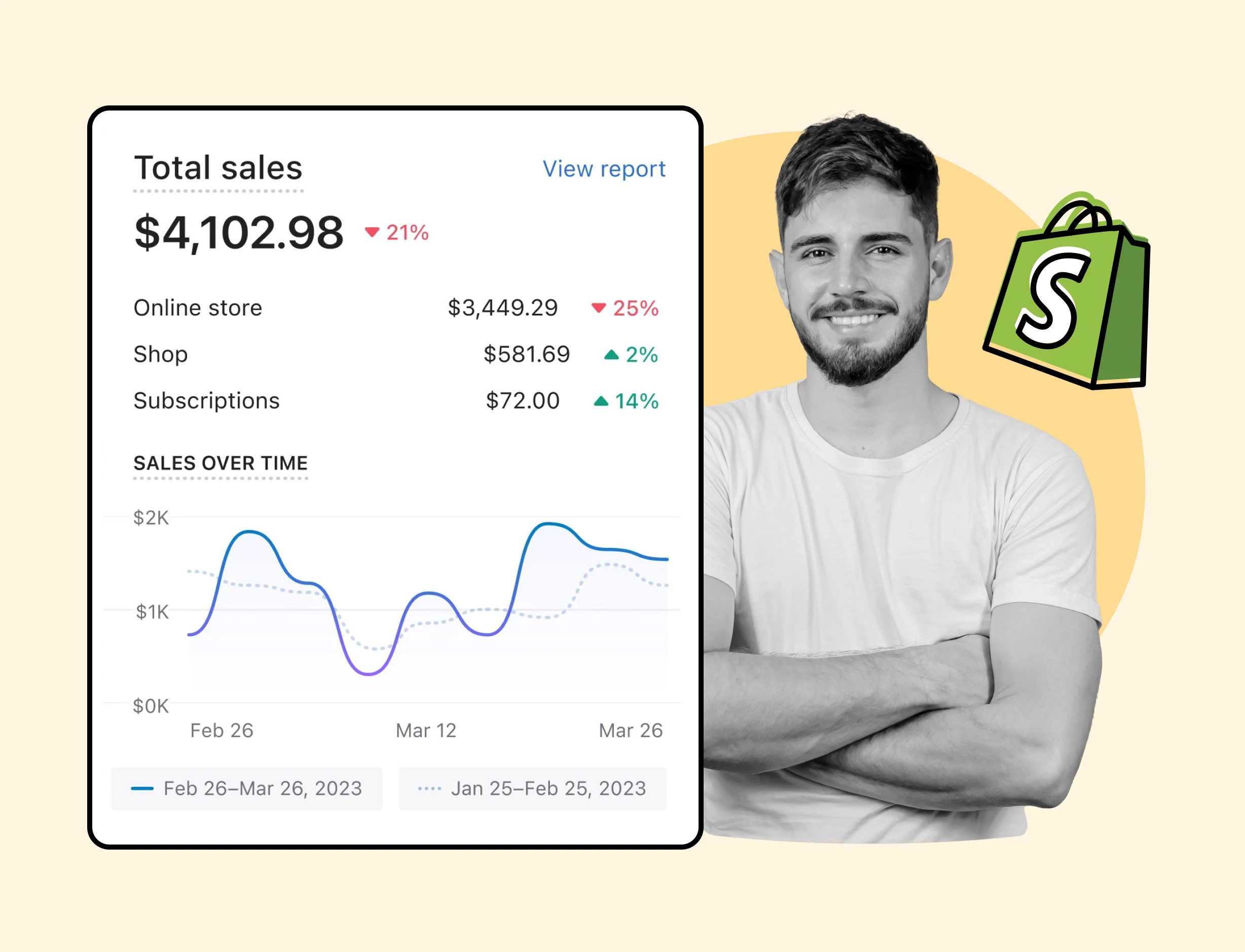
Ecommerce has become an integral part of our lives, providing convenience and ease in shopping. However, as an ecommerce business owner, one of the most pressing challenges faced is customer churn ecommerce. Reducing customer churn is vital for the long-term success of your online store. So, what can you do to keep customers coming back and foster loyalty? This blog post will provide you with valuable insights and strategies to help you understand, measure, and ultimately reduce customer churn in your ecommerce business. Get ready to transform your ecommerce store by turning churn challenges into opportunities!
Ecommerce businesses must understand customer churn to ensure profitability and sustainability.
Data-driven strategies such as journey mapping, personalization, loyalty programs and feedback are essential for reducing churn rates and increasing customer retention.
Utilizing analytics to detect early warning signs of increased churn is key in achieving ecommerce success on Shopify by adapting to the changing landscape.
WeSupply is an essential tool for Shopify stores focused on reducing customer churn. It offers personalized returns management, accurate estimated delivery dates, and proactive communication, supported by powerful analytics like CSAT and NPS.
Customer churn, defined as the rate at which customers stop conducting business with a company, significantly influences the performance of an ecommerce business. It affects repeat customers and has a direct impact on profitability. Given that the cost of acquiring a new customer through marketing is five times more than keeping an existing one, understanding and addressing customer churn becomes indispensable for the sustainability of your ecommerce store.
Let’s further explore the concept of customer churn and its effect on revenue.
Customer churn, also known as customer attrition, is the rate at which customers discontinue their transactions with a business, which immediately affects the business’s profitability by decreasing the total customer count and the revenue they generate. An increase in expenditure to acquire customers signals a higher number of customers leaving the business, which directly influences the churn rate. Hence, understanding the fundamentals of customer churn and its impact on your business’s profitability is essential.
Businesses can gain significant insights into their customer churn rate by monitoring key performance indicators (KPIs) like:
Average order value
Customer retention rate
Cart abandonment rate
Average profit per customer
Return on advertising spend
A robust and expanding average purchase value is positively associated with a reduced churn rate.
Understanding and addressing customer churn effectively can help businesses maintain a healthy churn rate, which in turn leads to improved profitability and sustainability.
Customer retention and churn are closely interlinked. While customer retention is the capacity to retain customers after their initial purchase, churn refers to the proportion of customers who stop using a product or service within a specified timeframe. Concentrating on preserving or augmenting customer retention is fundamental to reducing churn. Ultimately, the ideal customer is one who continually returns.
Elevating customer retention in ecommerce significantly affects churn rates. A rise in customer retention rates indicates that a larger number of customers are making repeat purchases and staying loyal to the ecommerce store, thereby lowering churn rates. Elevated customer retention rates signify customer satisfaction with the products, services, and overall experience provided by the ecommerce store, leading to bolstered customer loyalty and reduced churn. A mere 5% boost in customer retention can result in a profit increase of over 25%. By fine-tuning customer retention strategies, businesses can effectively lower customer churn and boost their overall profitability.
Identifying early warning signs of escalating churn is critical for proactive issue resolution. Recognizing high churn rate indicators and analyzing customer behavior enables businesses to adopt strategies that bolster customer retention.
In the ensuing sections, we will investigate key signals and patterns indicating high churn rates and the use of analytics to detect early warning signs in customer behavior.
Detecting key signals and patterns indicating high churn rates can offer invaluable insights into your ecommerce business’s health. Factors such as:
low brand visibility
poor customer service
product quality issues
competition with better alternatives
can contribute to high churn rates. Assessing customer engagement data and comparing your business’s performance against competitors can deepen your understanding of your churn rate and help you formulate strategies to tackle it.
A method to discern patterns indicating high churn rates is to consistently monitor KPIs related to churn rate. For instance, higher churn rates in certain categories, such as mobile and fashion, may point to potential problems or competition in those segments. Moreover, surveys suggest that a suitable yearly churn rate for SaaS companies is between 5 and 7%. Upon analyzing these indicators, businesses can preemptively tackle customer churn and take the required steps to enhance customer retention.
WeSupply underscores the importance of analytics in identifying high churn rates, offering tools to track vital metrics like CSAT and NPS. By focusing on these indicators, businesses can gain insights into their post-purchase customer experience, allowing them to tailor services to customer preferences and swiftly address issues in order fulfillment, product quality, or overall service, effectively reducing churn.
Customer behavior analytics assists businesses in pinpointing potential churn risks based on customer actions. Monitoring and analyzing customer behavior patterns like browsing history, purchase frequency, and marketing campaign engagement can help ecommerce businesses identify customers prone to churn. This enables businesses to take proactive measures, such as tailored marketing campaigns, personalized offers, and improved customer support, to retain those customers and avert churn.
Applying predictive analytics techniques can forecast customer churn based on historical data and identify contributing factors, enabling businesses to take preventive measures to lower churn risk. Remaining informed about customer preferences and tailoring strategies accordingly can help businesses boost their customer retention and lower churn rates.
Utilizing customer engagement data empowers businesses to detect pain points and devise strategies to improve the ecommerce experience.
WeSupply leverages return analytics and key metrics like CSAT and NPS to pinpoint potential churn risks, focusing on product-related factors such as size and quality. Its Order Flow Logistics Analytics provides a detailed view of the entire order process, from placement to delivery, including transit statuses and processing times. This comprehensive, data-driven insight allows businesses to refine their customer experience, proactively resolve issues, and effectively reduce churn.
To effectively counter customer churn, businesses need to implement comprehensive, data-driven strategies that tackle churn’s root causes and concentrate on enhancing customer retention. In the sections that follow, we will investigate the creation of a robust customer retention strategy and the leveraging of customer feedback and engagement for ongoing improvement.
A thoughtfully designed customer retention strategy is instrumental in reducing churn and boosting customer loyalty. Focusing on customer retention enables businesses to:
Enhance customer satisfaction
Foster loyalty
Build long-term relationships with customers
Increase revenue
Keeping existing customers is more cost-effective and advantageous for long-term sustainability, especially in the realm of subscription based businesses in the ecommerce landscape.
Consider the following strategies to formulate an effective customer retention strategy for an ecommerce business:
Dispatch exclusive promotional emails for repeat buyers
Deploy a customer loyalty program
Make use of SMS and email marketing to win back customers
Provide personalized customer experiences
Leverage zero-party and first-party data for a better understanding of customer preferences
These strategies can aid in constructing strong relationships with customers and motivate repeat purchases, leading to improved customer retention.
Customer feedback and engagement serve as priceless resources for ongoing improvement in the ecommerce realm. Businesses can identify areas for improvement and fine-tune their customer retention strategy by:
Gathering and analyzing customer feedback
Interacting with customers and addressing their issues
Fostering trust and loyalty
Ultimately contributing to churn reduction.
Businesses can utilize various tactics to leverage customer feedback and engagement for continuous improvement, including:
Gathering feedback via surveys and reviews
Monitoring social media channels for customer insights
Analyzing customer data to identify pain points and areas for enhancement
Remaining informed about customer preferences and tailoring strategies accordingly can help businesses boost their customer retention and lower churn rates.
WeSupply stands at the forefront of combating customer churn, offering a comprehensive suite of post-purchase tools designed to optimize customer retention and enhance the overall shopping experience.
Key Features of WeSupply in Combatting Customer Churn:
Boost average order value with instant store credit for exchanges.
Rewards for customers choosing store credit over refunds.
Redirect customers to the product catalog after initiating a return.
Exchange return items for any product, including higher value items.
Personalized tracking page to increase brand awareness and engagement.
Keep customers updated without third-party tracking sites.
Shoppable experience with product recommendations and promotions.
Elevate marketing with social media links and communication platforms.
Insights into most returned products and return reasons.
SKU level analytics for product feedback.
Understand regional return trends and impact on customer lifetime value.
Tools to measure Customer Satisfaction and Net Promoter Score.
Data-driven approach for continuous optimization of customer experience.
Discover the full potential of WeSupply in transforming your customer retention strategies. Don’t miss out on the opportunity to elevate your post-purchase experience – Book a demo with WeSupply today and see the difference for yourself!
Customer experience significantly impacts customer retention and churn rates. A positive shopping experience can entice customers to return, whereas a negative one can result in churn.
In the subsequent sections, we will delve into enhancing the ecommerce customer experience through journey mapping to identify and tackle pain points and personalizing the shopping experience for heightened engagement.
Customer journey mapping is a crucial instrument for detecting and resolving pain points in the ecommerce experience. Businesses can identify areas for improvement, enhance the user experience, and boost customer retention by analyzing and visualizing the stages and experiences customers undergo when interacting with an ecommerce store.
Some common issues that customers experience during their ecommerce journey include:
Slow-loading websites
Lack of customer support
Complex checkout processes
Limited payment options
Hidden fees
Difficulties in product discoverability
Businesses can optimize the shopping experience, leading to higher customer retention and reduced churn, by plotting the customer journey and tackling these pain points.
Personalizing the shopping experience can have a notable effect on customer engagement and loyalty. Businesses can create a more engaging and satisfying shopping experience by offering customized recommendations and experiences based on user preferences and browsing/purchase history.
Some effective personalization strategies for ecommerce include:
Product recommendations
Personalized content
Targeted promotions
Customized search results
Implementing these strategies can help businesses boost customer engagement, nurture loyalty, and decrease the chances of churn.
WeSupply elevates e-commerce engagement by providing a personalized Returns Center, featuring a fully branded portal that facilitates a unique, omnichannel journey. It includes custom tracking pages and branded communication via email and SMS, all designed to match your brand’s aesthetics. This tailored approach not only smoothens the post-purchase process but also boosts customer loyalty and continued engagement, seamlessly blending every stage from purchase to return into a cohesive brand experience.
Combat inconvenience with proactivity & self service
Book a quick call with our experts to see how WeSupply can help you make returns easy for your customers with a beautiful, self-service solution that makes their experience easier while also providing new ways to lower costs and earn back revenue.
Calculating and comprehending your ecommerce churn rate is vital for evaluating your business’s performance and pinpointing areas for improvement. Determining and interpreting churn rates enables you to gain actionable insights to guide business decisions and enhance customer retention.
In the following sections, we will explore the detailed breakdown of churn rate calculation formulas and the interpretation of churn data for actionable business insights.
To calculate churn rate in ecommerce, follow these steps:
Determine the number of customers who have left your store during a specified period.
Calculate the total number of customers at the beginning of that period.
Divide the number of customers who have left by the total number of customers.
Multiply the result by 100 to get the churn rate as a percentage.
It’s noteworthy that the relevant benchmarks and acceptable churn rates may vary based on the industry and business model.
For subscription-based ecommerce businesses, the churn rate formula is slightly different: (Customers at the start of the period – Customers at the end of the period + New Customers Acquired in the Period) / Customers at the start of the period. Including “New customers acquired in the period” when calculating churn rate for subscription ecommerce businesses is essential to prevent the churn rate of existing customers from being obscured by newly acquired customers.
Analyzing churn data can offer valuable insights into your ecommerce business’s health and guide your customer retention strategies. Some key steps to consider are:
Segmenting your customer base
Monitoring key performance indicators (KPIs) like purchase frequency, average order value, and customer lifetime value
Deeply understanding your target customers
Identifying areas for improvement
By following these steps, you can gain a better understanding of your customers and make informed decisions to improve customer retention and customer acquisition.
To enhance your customer retention strategy and lower churn, consider concentrating on the following steps:
Identify customer segments with high churn rates.
Resolve their specific pain points.
Utilize advanced analytics and predictive modeling techniques to identify customers at risk of churning.
Preemptively tackle the issue and formulate customer retention strategies.
Cultivating customer loyalty is vital for reducing churn and preserving a healthy customer base. In the subsequent sections, we will explore the deployment of loyalty programs like points, discounts, and rewards, and the significance of prioritizing top-notch customer support as a retention tool.
Providing incentives to promote repeat purchases and customer loyalty is a proven method to lower customer churn. Some examples of loyalty programs include:
Points systems, where customers earn points for each purchase that can be redeemed for discounts or rewards
Discounts for repeat purchases, such as a percentage off for every subsequent purchase
Rewards programs, where customers earn rewards based on their spending or engagement with the brand
These loyalty programs can provide incentives for repeat purchases, foster customer retention, and offer savings and rewards to customers, thus benefiting customer retention.
Consider the following strategies to successfully deploy a loyalty program:
Cashback rewards
Point-based loyalty systems
Referral bonuses
VIP and membership benefits
Subscription savings
Cause-based rewards
By providing these incentives, businesses can bolster customer loyalty, enhance customer retention, and ultimately lower customer churn.
WeSupply offers a dynamic solution to transform returns into exchanges, enhancing customer retention and increasing order value. Customers can easily exchange items for any product, including higher valued items, or opt to reship the same item. By incentivizing exchanges over returns through instant store credit rewards, WeSupply encourages customers to revisit the product catalog, boosting sales and building trust. Additionally, the platform streamlines refunds by automatically issuing store credits, gift cards, or coupon codes. This seamless exchange process, akin to shopping on your website, not only elevates the customer experience but also significantly contributes to customer loyalty and lifetime value, effectively reducing churn.
Top-notch customer support is a critical element in retaining customers and reducing churn. Customers satisfied with the customer service provided by the customer support team are more likely to remain loyal to the business and continue making purchases. On the contrary, inadequate customer service can greatly intensify customer churn.
Consider implementing an omnichannel strategy to reach customers. This includes:
Providing real-time support with live chat
Dispatching email campaigns with promotional offers
Setting up an SMS marketing campaign
Soliciting feedback to enhance customer service processes
By prioritizing customer support as a retention tool, businesses can effectively address customer concerns, enhance customer satisfaction, and reduce churn.
WeSupply prioritizes exceptional customer support as a key retention strategy, offering proactive communication through Email and SMS notifications. The platform keeps customers informed about order updates, reducing the need for inquiries and enhancing the shopping experience. Its omnichannel tracking centralizes orders from various sources, providing a single reliable portal for order status, thus streamlining the shipping process and alleviating shipping anxiety. By ensuring customers are consistently updated about their order’s progress and expected delivery dates, WeSupply not only improves the efficiency of the Customer Service Team but also significantly boosts customer satisfaction and trust, effectively reducing churn.
Keep your customers engaged during the delivery experience
Book a quick call with our experts to see how WeSupply can help you engage your customers with relevant updates through the right channel, at the right time.
Using data analysis and customer feedback is fundamental for enhancing customer retention rates. In the subsequent sections, we will investigate how to monitor and respond to customer engagement and complaints, and adapt to shifting market conditions and evolving customer preferences.
Keeping track of customer interactions and resolving concerns is essential for boosting customer satisfaction and reducing churn. By tracking customer engagement through various channels, such as email, social media, and customer reviews, businesses can gain valuable insights into customer behavior and preferences.
Addressing customer complaints and concerns is vital for retaining customer loyalty and reducing churn. To systematically track and address customer complaints, consider the following steps:
Establish a dedicated channel for customers to submit their complaints.
Express empathy by acknowledging and apologizing for the complaint.
Investigate and resolve the complaint by tackling the root cause.
Follow up with the customer to ensure their satisfaction and provide updates on the resolution.
By following these steps, you can effectively address customer complaints and maintain a positive relationship with your customers.
Effective tracking and addressing of customer complaints can enable businesses to enhance customer satisfaction and retention.
Remaining agile and adaptable to changes in the ecommerce landscape and customer preferences is vital for sustained success. As customer needs and market conditions change, businesses must adapt their strategies and offerings to continue meeting the demands of their target audience.
Businesses can remain competitive and responsive to evolving customer needs by collecting and analyzing customer feedback, keeping abreast of emerging technologies and market trends, and investing in ongoing improvement and innovation. Remaining informed about customer preferences and tailoring strategies accordingly can help businesses boost their customer retention and lower churn rates.
WeSupply advocates for using analytics and feedback as essential tools for customer retention. By enabling businesses to track critical metrics like CSAT and NPS, WeSupply helps identify areas of improvement in the post-purchase experience. This approach allows for precise adjustments based on real feedback, turning challenges into opportunities for enhancing customer loyalty and retention.
In conclusion, mitigating customer churn is an enduring challenge that necessitates a comprehensive approach, encompassing:
Understanding customer churn
Identifying early warning signs
Executing customer retention strategies
Enhancing the ecommerce customer experience
Computing and understanding churn rates
Benchmarking and minimizing different types of churn
Fostering customer loyalty
Utilizing analytics and feedback for customer retention.
By utilizing these strategies, ecommerce businesses can convert churn challenges into opportunities, thus increasing profitability and ensuring long-term success.
For achieving ecommerce success on Shopify, businesses should integrate various strategies to optimize customer retention and reduce churn. Businesses can cultivate customer loyalty and minimize churn by focusing on customer retention, enhancing the shopping experience, and addressing pain points. Deploying loyalty programs, prioritizing outstanding customer support, and using analytics and feedback are also crucial for establishing a successful ecommerce business on Shopify.
By amalgamating these strategies, businesses can optimize their customer retention efforts and establish a more robust and successful ecommerce business. As the ecommerce landscape continues to evolve, businesses must stay agile, innovative, and responsive to their customers’ changing needs to preserve their competitive edge.
The future of ecommerce appears promising, with anticipated continued growth and innovation in the forthcoming years. As the ecommerce landscape evolves, businesses, including ecommerce stores, must adapt to market shifts and customer needs to retain their competitive edge. By keeping abreast with emerging technologies, market trends, and customer preferences, businesses can stay ahead of the curve and ensure their long-term success.
Businesses can continue to grow and prosper in the ever-evolving ecommerce landscape by leveraging customer engagement data, staying agile, and adapting to market changes. With a pronounced focus on customer retention and loyalty, businesses can successfully curtail churn and maintain a healthy, sustainable customer base.
In summary, understanding and addressing customer churn is essential for the long-term success of an ecommerce business. By implementing comprehensive strategies, such as focusing on customer retention, enhancing the customer experience, and leveraging analytics and feedback, businesses can effectively reduce churn and maintain a loyal customer base. As the ecommerce landscape continues to evolve, businesses must stay agile and responsive to changing customer needs in order to thrive in this dynamic environment. Embrace the challenge of reducing customer churn and turn it into an opportunity for growth and success.
WeSupply is a robust solution tailored for Shopify stores, aimed at decoding and reducing customer churn in e-commerce. It enhances the post-purchase experience with personalized return and exchange portals, proactive Email and SMS updates, and a comprehensive tracking system for all orders. A key feature is its Estimated Delivery Date functionality, which provides customers with accurate delivery timelines, further reducing anxiety and improving satisfaction. WeSupply’s advanced analytics, including CSAT and NPS tracking, empower businesses to make informed decisions based on customer feedback. This integration of detailed analytics and customer-focused features makes WeSupply an invaluable tool for Shopify stores looking to understand and minimize customer churn, ultimately bolstering customer loyalty and retention.
eCommerce customer churn refers to the number of customers who cease buying from an online store over a given period, represented by the churn rate. It’s essential for online businesses to understand their churn rate and implement strategies to reduce it.
To calculate customer churn rate in eCommerce, divide the number of customers lost by the total number of customers at the start of a specific time period, then multiply it by 100 to get the percentage.
On average, ecommerce businesses see a churn rate of 5-26%, depending on their size and sector.
Focusing on customer retention, enhancing the shopping experience, addressing pain points, implementing loyalty programs, prioritizing exceptional customer support, and utilizing analytics and feedback are effective strategies for reducing customer churn.
WeSupply is a post-purchase platform that helps ecommerce businesses, particularly Shopify stores, reduce customer churn. It enhances the customer experience with features like personalized returns management, proactive communication, and accurate delivery estimates, all backed by insightful analytics.
Yes, WeSupply is designed to integrate seamlessly with Shopify stores, providing a cohesive post-purchase experience that aligns with the store’s branding and operational flow.
While WeSupply is particularly beneficial for Shopify stores, its features and analytics capabilities can be advantageous for a wide range of ecommerce businesses looking to reduce churn and improve customer retention.
WeSupply offers analytics tools like Customer Satisfaction (CSAT) and Net Promoter Score (NPS) to track and understand customer feedback and satisfaction, which are crucial in identifying and addressing factors leading to customer churn.

Learn How To Create Successful Post Purchase Email Campaigns
Build an effective post-purchase email flow that helps you increase customer satisfaction and drive revenue growth!

Discover the importance of returns in e-commerce and how a well-managed return process can improve customer satisfaction and drive business success.
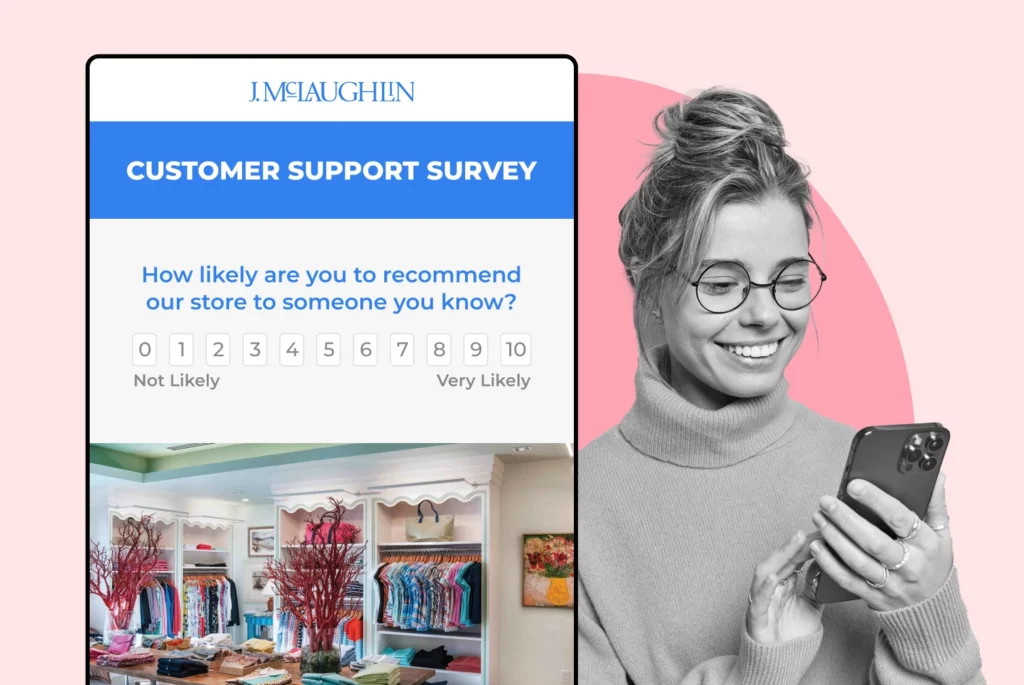
Understand, minimize, & prevent post-purchase cognitive dissonance, transforming the shopping experience for customers and businesses alike.

Explore the key factors that contribute to the most loved returns experiences, the return policies of retail giants, and the benefits of customer-centric return policies.

Dive deep into the world of post-purchase behavior and uncover the secrets to long-lasting, profitable customer relationships.

Discover the power of post-purchase software solutions and learn about the top solutions available to create loyal customers and drive growth in your e-commerce business.
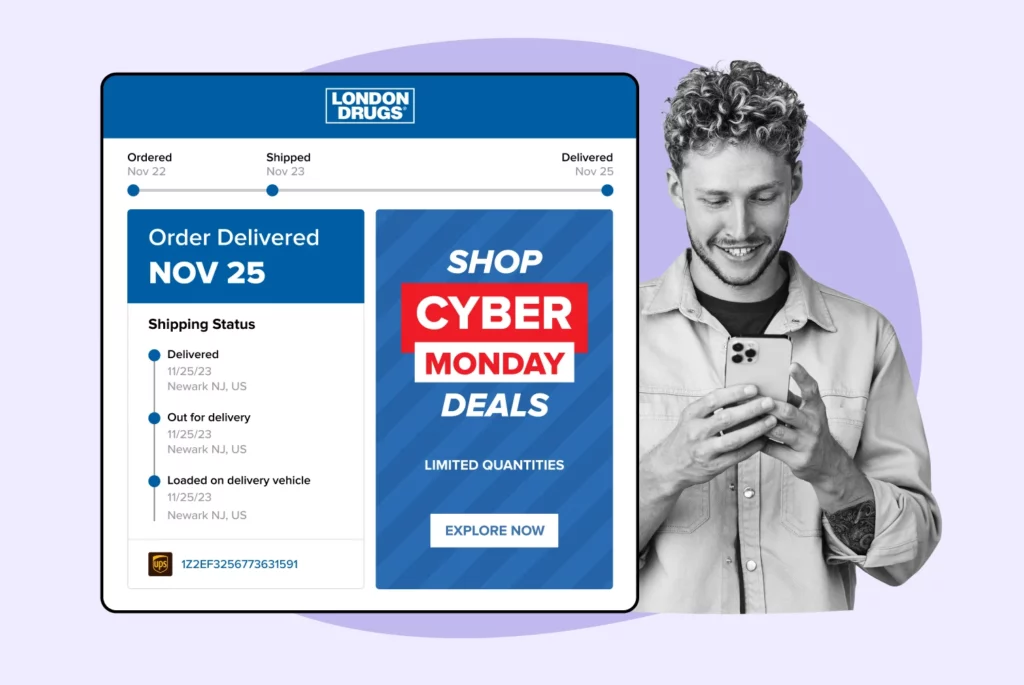
In this blog post, we explore various strategies to maximize customer retention Cyber Monday and ensure your business reaps the rewards during this critical time.
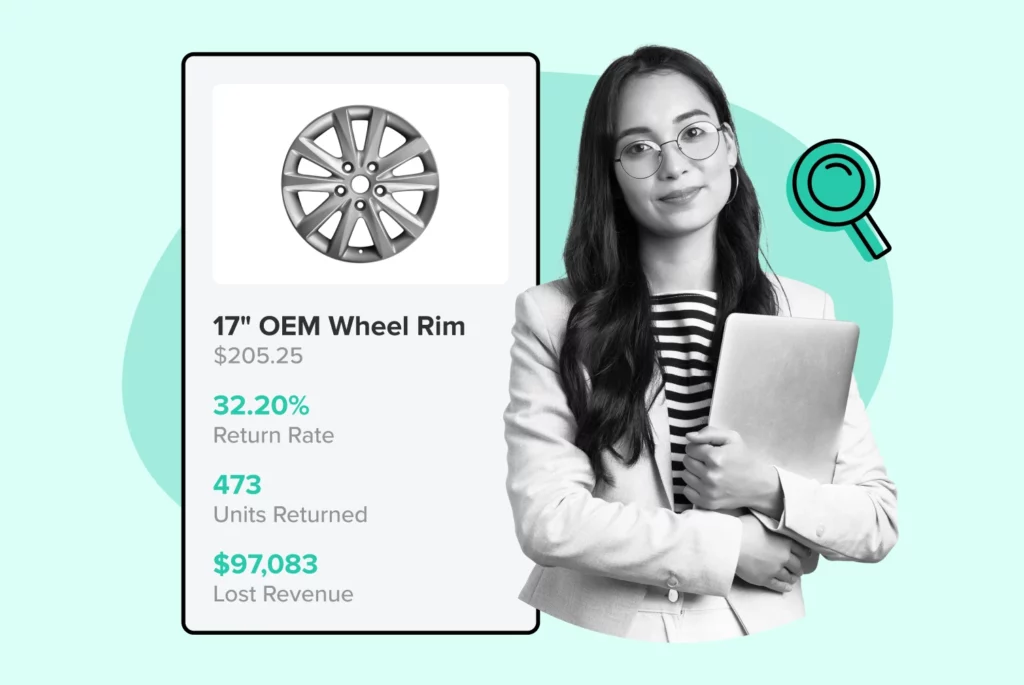
Let’s explore the potential of returns data and how you can use it to revolutionize your ecommerce business.

Let’s explore the importance of post-purchase engagement, the key elements of a successful post-purchase experience e-commerce, and the strategies businesses can employ to maximize customer retention and satisfaction.

In this blog post, we will explore the importance of returns management in e-commerce customer retention and the cost and impact of customer acquisition vs. customer retention returns.